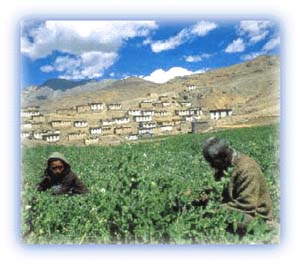Lahaul and Spiti
General Info
· Lahaul
· Baralacha Range
· Chandra Valley
· Bhaga Valley
· Keylong
· Chandra-Bhaga Valley
· Great Mountain Mass
· Lingti Plains
· Spiti
· Climate
· Kaza
· Pin Valley
Other Places of Interest
Passes
· Baralacha Pass
Rivers
· Chandra River
· Chandra - Bhaga
· Spiti River
Glaciers
· Bara Shigri Glacier
Lakes
· Chandratal Lake
· Suraj Tal Lake
People
· Lahaulas
· Tradition & culture
Religion
Fairs and Festivals
History
· Lahaul
· Spiti
Visual Delights

![]()
The people and the culture of Spiti evolved over the centuries largely isolated from the rest of the world. The population of Spiti had to deal with two problems. Arable land was one problem -- not much of it is available in this barren region. The other problem was that of the rising population. Unlike the neighboring regions of Lahaul and Kinnaur, polyandry is not followed in Spiti. |
 |
| Girls from Kaza, Spiti Credit: Discover India |
In the Spiti system, the eldest son inherits the property. The eldest daughter gets the mother's jewellery. The younger siblings get nothing. They have to fend for themselves. Many usually fall back on the social security system of the Trans Himalayas -- the monasteries and nunneries. This is one of the reasons why even today religion plays a major role in the lives of the people.
All rights reserved
